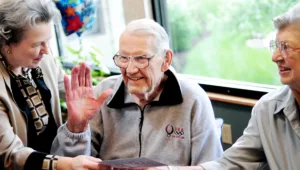Testimony of George W. Parker
D-Day veteran
He died on May 27, 2009, at the age of 86.
“June 6, 1944. My 19th mission. We were awakened at 1:15 a.m. and then hurried to hear the briefing from our commanding officer, Colonel Richard T. Coiner, who read us three letters from General Brerton greeting all the bomber crew members taking part in the pre-invasion operations. Then we received another letter, this time from Supreme Commander Eisenhower. Colonel Coiner finally let us know that it was the big day!
General Samuel Anderson also came to the briefing and began a speech on the progress of operations. Ground troops (U.S. 1st Army and Allied soldiers) were to land at 6:30 a.m. on beach sectors in Normandy. Our role was to spearhead the attack by bombing German defensive installations on the beaches and inland in the area of the future beachheads. Quite a program…
We took off at 4:014 a.m. in the twilight, the ceiling was at 3,000 feet, and it was raining heavily in the English countryside… Fortunately, I was among the lead aircraft of Fleet B under Captain William J. Rhodes. I was flying second (to the right of the lead aircraft) in a group of six bombers, leading the first squadron of eighteen other aircraft.
Visibility was so low that the four aircraft already in the air only found us at a rendezvous point over Hastings at 12,000 feet. Daylight was already breaking. After leaving our airport, Captain Rhodes and I headed toward the rendezvous point. We flew for about ten minutes through small cloud formations at about 9,000 feet, and we noticed ice forming on the wings, on top of the cockpit, on the gunners’ turrets, and in other visible areas. When daylight As night gradually dawned, we could see a myriad of aircraft in the sky. We found and rendezvoused with our squadron leader, Major Robert M. Mcleod, and then headed for the coast.
The coast we were heading for was Sainte Catherine on the Isle of Wright. At dawn, we could see ships below our aircraft, warships of all sizes and types, following one after the other, arranged in different formations… incredible!
It was the first time I had seen so many ships. Probably the largest amphibious operation of all time. We arrived off the Cotentin Peninsula and began bombarding the French coast (we were at an altitude of about 12,000 feet). We left behind a large plume of smoke. The artillery fire from Allied ships and German guns increased the havoc.
The sky over the invasion zone was crisscrossed by a multitude of different squadrons. of all kinds. We lowered our aircraft to 5,000 feet, then attacked the designated targets (such as artillery strongpoints on the coast) before giving way to other bombers, which also had to complete their missions before the troops began landing.
Our bombs were dropped at 6:21 a.m., and no bombing raids could be carried out after 6:25 a.m., as there was a high risk of causing a disturbance among the disembarked troops.
Colonel Brown of the 98th Bomb Wing, several war correspondents (including the public relations officer, Lieutenant Charles Cook), Colonel Richard Coiner, and Colonel Rollin Winningham took part in this attack. Our objective on D-Day was the installations at the Dunes-de-Varreville strongpoint (Utah Beach). General Eisenhower designated our group of B-26 Marauders to bomb the Utah Beach area. Our group, the 397th, received a second mission on June 6, but I was not part of it.”
George W. Parker

